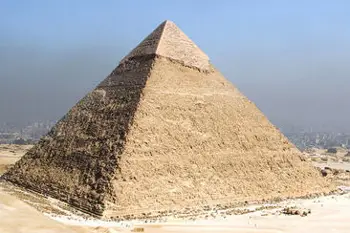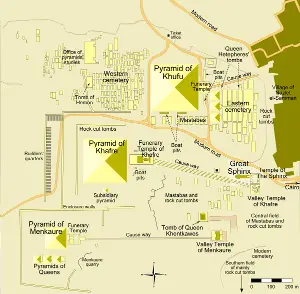Giza: Site of the Great Pyramids, Great Sphinx
Giza was a burial site for the kings and other leaders of Ancient Egypt for a very long time. However, the site is most well-known for three giant pyramid-shaped tombs, the largest of which is the Great Pyramid. 
The Great Pyramid, one of the Seven Ancient Wonders of the World, was built for the pharaoh Khufu, is 750 feet long on each side and stretches 480 feet in the air. The chief architect of the Great Pyramid was Khufu's chief chancellor and nephew, Hemiunu. It took 20 years to build. Workers hauled 2.3 million limestone blocks, each weighing between 2 and 15 tons, from locations near and far and then placed them with near precision into the shape that is so familiar today but then was the first of its kind. The Pyramid was meant to serve as Khufu's tomb. Inside were chambers for him and for a queen, connected by the Grand Gallery. Found near the Pyramid was an elaborate funerary boat, the largest of its kind, made of tamarix, or salt cedar. It is 143 feet long and almost 20 feet wide. Later generations discovered Khufu's sarcophagus but not his mummy. It has yet to be found. Discovered much later was Khufu's solar barge, the oldest intact ship yet discovered; it was 143 feet long and 19 feet wide and was found buried in a pit near the Great Pyramid. 
When Khufu died, his oldest surviving son, Djedefre, succeeded him on the throne. (Khufu's oldest-born son, Kawab, had predeceased him in mysterious circumstances.) Another of Khufu's sons became king not long afterward, and he built a giant pyramid near his father's. Khafre's pyramid is on the highest ground, giving it the illusion that it is the tallest around. The third of the very large pyramids at Giza was built for Khafre's son, Menkaure. This tomb is a bit different from the others in that the highest parts are brick, not limestone. These large pyramids were built mostly of limestone that was polished; later kings used most of that for their own building projects. The three large pyramids were completed within a few decades of one another: Khufu's was finished in 2560 B.C., Khafre's in 2530 B.C., and Menkaure's in 2510 B.C. 
The completion of the Great Sphinx was ten years after that. The giant 240-foot-tall long and 66-foot-high mythical creature (having the head of a person but the body of a lion) reclines on the west bank of the Nile and faces directly from west to east. (The three great pyramids are also aligned astronomically, nearly precisely north-south and east-west; historians still don't know.) Historians generally think that the face is that of Khafre, although that and many other details about the structure remain unknown. 
Archaeologists have found earlier tombs at Giza, some dating back to the First Dynasty, such as the very early king Djet. Also found have been smaller pyramids and other tombs built for the royal wives of the kings for whom the greater pyramids were built. Other cemeteries have been found there (containing mastabas for royal children and officials), as has the remains of the village in which resided the workers who toiled those long years to build the great pyramids. One later pharaoh who was particularly interested in Giza was Ramses II. He had a temple for himself built there, next to the Great Sphinx. His fourth son, Khaemweset, restored Giza to its former glory, and the site was again used as a necropolis for many years afterward. Other later pharaohs who had various additions installed at Giza included Thutmose I, Amenhotep II, Thutmose IV, Tutankhamen, and Seti I. |
|
Social Studies for Kids
copyright 2002–2024
David White




